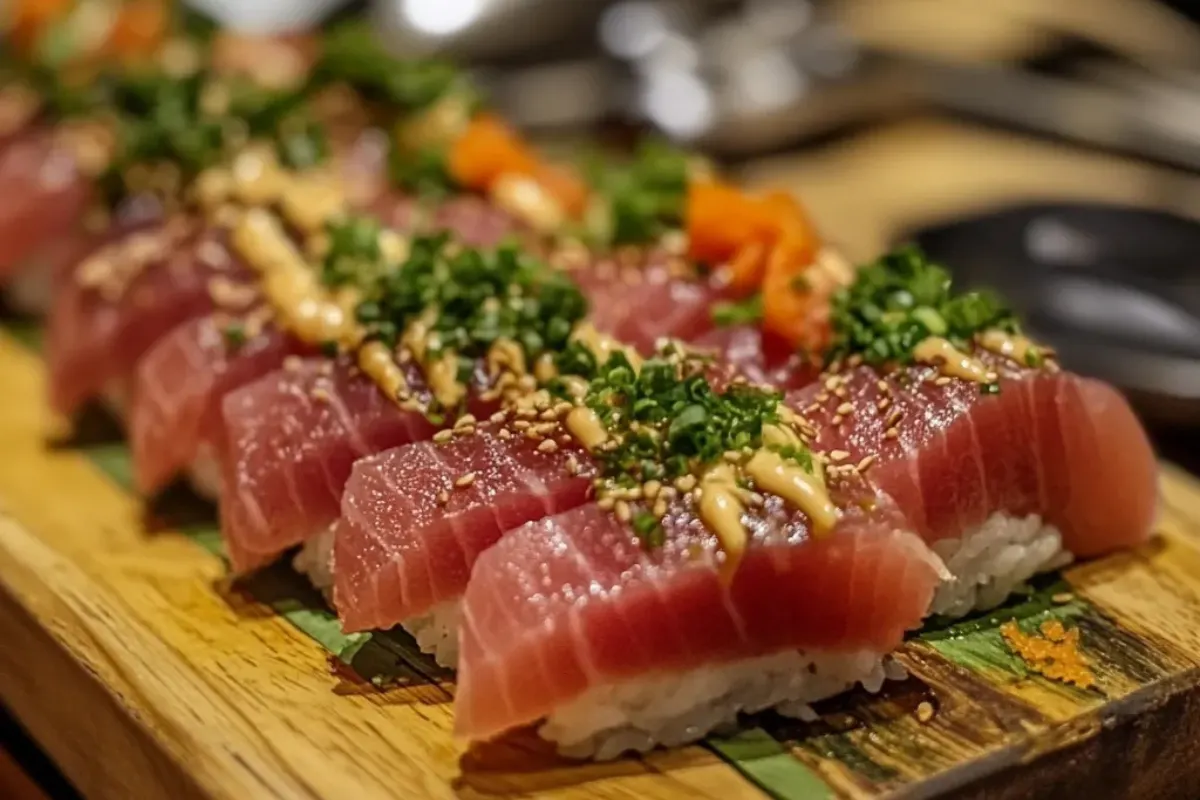Sushi is more than a meal; it’s an art form that captures the essence of fresh, high-quality seafood. At the heart of this culinary masterpiece is sushi grade tuna, a term that sparks curiosity and excitement among sushi enthusiasts. Whether you’re a budding home chef or an experienced foodie, understanding what makes tuna “sushi grade” is key to elevating your dishes. In this article, we’ll dive deep into the definition, types, preparation methods, buying tips, and much more.
Definition and Standards
Sushi grade tuna isn’t a regulatory term but rather a commercial one. It refers to tuna deemed safe to eat raw due to its exceptional freshness and handling standards. This includes freezing the fish at extremely low temperatures to eliminate harmful parasites, a practice recommended by the Food and Drug Administration (FDA).
To qualify as sushi grade, the fish must meet strict quality criteria. Its color, texture, and smell are scrutinized rigorously. Bright red or pinkish hues, firm flesh, and a clean, oceanic aroma are hallmarks of high-grade tuna. Unlike regular tuna, which might be cooked or canned, sushi grade tuna is specifically prepared for raw consumption, ensuring a delightful sashimi experience.
How it Differs from Regular Tuna
Ever wondered why not all tuna is sushi-worthy? The difference lies in handling and preparation. Regular tuna might be perfectly fine for grilling or searing but could pose health risks if consumed raw due to parasites. Sushi grade tuna, on the other hand, undergoes deep freezing at temperatures as low as -31°F (-35°C). This not only preserves its taste and texture but also guarantees it’s parasite-free.
Additionally, it is typically sourced from premium cuts, such as the loin or belly, which are prized for their buttery richness. These cuts melt in your mouth, making them perfect for sushi and sashimi.
Types of Sushi Grade Tuna
Bluefin, Yellowfin, and Ahi Tuna
When it comes to sushi grade tuna, not all tuna is created equal. Some varieties stand out for their flavor, texture, and suitability for raw dishes. Bluefin tuna, often referred to as the “king of tuna,” is the most prized for sushi and sashimi. Its marbled, fatty cuts, especially otoro (the belly), are a luxurious treat.
Next is yellowfin tuna, also known as ahi tuna. It’s slightly leaner than bluefin but still offers a silky, rich texture that works beautifully in sashimi and poke bowls. For a more budget-friendly option, skipjack tuna, often labeled as bonito, is another choice. While less rich, it’s still a popular ingredient for sushi rolls and tataki dishes.
Saku Blocks vs. Hand-Cut Pieces
Ever seen those perfectly rectangular slabs of tuna in your local fish market? Those are saku blocks, pre-cut portions of sushi grade tuna designed for consistency and convenience. They’re ideal for slicing sashimi or cubing for poke.
On the other hand, hand-cut pieces provide a more rustic and artisanal approach. These cuts, often prepared fresh from the whole fish, can include premium sections like chutoro (medium-fatty tuna) or akami (lean tuna). While saku blocks are practical, hand-cut pieces offer unparalleled freshness and variety.
Understanding the types of sushi grade tuna helps you choose the right one for your culinary adventure, whether you’re crafting elegant nigiri or hearty tuna tartare.
How is Sushi Grade Tuna Prepared?
The Freezing Process to Guarantee Safety
The journey of sushi grade tuna from ocean to plate involves meticulous care. To make raw consumption safe, the FDA mandates freezing fish at ultra-low temperatures to kill parasites. Most sushi grade tuna is flash-frozen on fishing vessels immediately after being caught. This process locks in freshness, preserves its texture, and guarantees safety.
The deep freezing is no ordinary process—it happens at -31°F (-35°C) or colder. This method eliminates harmful organisms without compromising the fish’s integrity. As a result, the tuna remains firm, vibrant, and melt-in-your-mouth delicious when thawed properly.
Regulations and Requirements
To make sure consumer safety, the FDA provides clear guidelines on preparing raw seafood. Only fish that has been frozen according to their standards can be labeled as sushi grade. This includes specific time and temperature requirements, such as freezing for seven days at -4°F (-20°C) or for 15 hours at -31°F (-35°C).
Moreover, tuna is unique because it doesn’t carry the same parasite risks as other seafood. While freezing is still crucial, tuna is considered a safer choice for raw dishes. However, handling practices, such as maintaining a clean environment and proper thawing, are equally important for preserving the quality of sushi grade tuna.
Understanding these preparation methods guarantees that your sushi experience is as safe as it is delicious. With this knowledge, you can confidently enjoy sushi grade tuna in all its raw, delectable glory. Next, we’ll discover where to find the freshest tuna for your home sushi projects.
Where to Buy ?
Local vs. Online Stores
When it comes to buying sushi grade tuna, the choice between local markets and online stores often boils down to convenience and trust. Local fish markets are great for those who prefer seeing the product before purchasing. You can check the tuna’s color, texture, and smell to make sure its quality. Look for markets specializing in fresh seafood or those catering to sushi chefs.
On the other hand, online seafood retailers offer unparalleled convenience. Many trusted websites deliver flash-frozen sushi grade tuna directly to your door. These suppliers follow strict freezing and handling protocols to maintain freshness. Popular options like Catalina Offshore Products or Great Alaska Seafood make sure you’re getting top-quality fish without leaving your home.
Top Recommended Retailers
For the freshest sushi grade tuna, consider these reliable sources:
- Catalina Offshore Products: Known for their wide selection of sashimi-grade seafood, including yellowfin and bluefin tuna.
- Sizzlefish: Offers individually portioned ahi tuna, perfect for sashimi or poke bowls.
- Oceanside Seafood: Features a variety of sashimi-grade options, delivered fresh or frozen.
For more delicious seafood ideas, check out our Tuna Sashimi Guide, which includes tips and techniques for preparing perfect sashimi dishes.
How to Select the Best Sushi Grade Tuna
Freshness Indicators
Selecting the best sushi grade tuna starts with understanding what to look for. The fish should have a vibrant red or pinkish color, a sign of freshness and high quality. Avoid tuna with dull or brownish hues, as this indicates it’s past its prime. Additionally, the texture should be firm and slightly springy when touched.
A clean, oceanic smell is another key indicator of freshness. If the tuna smells overly fishy or sour, it’s best to steer clear. Always inspect the packaging for any signs of damage or frostburn if you’re purchasing frozen tuna.
Signs of Poor Quality
Recognizing poor-quality tuna can save you from a disappointing meal. If the tuna feels mushy or sticky, it’s a clear red flag. Similarly, excessive liquid in the packaging may indicate improper freezing or thawing, which compromises the texture and flavor.
When buying online, check for certifications or guarantees from the seller. Reliable vendors of sushi grade tuna will always provide details about their sourcing, freezing methods, and quality standards. Ensuring you buy only the best tuna makes all the difference when crafting your sushi dishes.
With these tips in mind, you’re well on your way to selecting tuna that delivers both safety and exceptional taste. Up next, we’ll dive into creative ways to use sushi grade tuna in recipes.
Sushi Grade Tuna Recipes and Uses
Popular Recipes: Sashimi, Poke, Tartare
Sushi grade tuna opens a world of culinary possibilities, with dishes ranging from simple to gourmet. One of the easiest and most elegant ways to enjoy it is sashimi—thinly sliced pieces of raw tuna served with soy sauce, wasabi, and pickled ginger. For a quick and refreshing option, try making a poke bowl. Combine cubed tuna with soy sauce, sesame oil, green onions, and sesame seeds, then serve over rice.
Tuna tartare is another favorite, offering a blend of flavors and textures. Mix diced sushi grade tuna with avocado, capers, and a dash of lemon juice. Serve it with crackers or cucumber slices for a delightful appetizer. These recipes not only highlight the tuna’s natural flavor but also make it easy to replicate restaurant-quality dishes at home.
For more inspiration, check out our Hawaii Poke Recipes, which delve into the history and techniques behind this iconic dish.
Tips for Home Sushi Making
Making sushi at home can be both fun and rewarding. Start with the freshest sushi grade tuna you can find, as the quality of the fish is crucial for raw dishes. When preparing sushi, always use a sharp knife to achieve clean, precise cuts. This guarantees the tuna retains its texture and presentation.
For nigiri, form small mounds of vinegared rice and place thin slices of tuna on top. For rolls, pair the tuna with complementary ingredients like cucumber, avocado, or spicy mayo. Don’t forget to serve with high-quality soy sauce and freshly grated wasabi to increase the flavors.
These recipes and tips make creating sushi at home an enjoyable and satisfying experience.
FAQs
What Makes Tuna Sushi Grade?
Sushi grade tuna is distinguished by its freshness, handling, and safety for raw consumption. It’s flash-frozen at extremely low temperatures to eliminate parasites, making it safe to eat without cooking. The quality is also apparent in its vibrant color, firm texture, and clean taste.
Can Any Tuna Be Used for Sushi?
Not all tuna is suitable for sushi. Regular tuna might contain parasites or lack the freshness needed for raw dishes. Only sushi grade tuna that meets FDA freezing requirements and is sourced from trusted suppliers should be used for sushi and sashimi.
Is Sushi Grade Tuna Safe for Pregnant Women?
While sushi grade tuna is safe for most people, pregnant women should consult their doctor before consuming raw fish. Some species, like bluefin tuna, have higher mercury levels, which can be harmful during pregnancy.
For more guidance on seafood safety, discover our Seafood Boil Sauce Recipe for cooked alternatives that deliver bold flavors without the raw element.
Sustainability and Environmental Considerations
Impact of Tuna Fishing on Marine Ecosystems
The popularity of sushi grade tuna has brought attention to its environmental impact. Overfishing of species like bluefin tuna has led to declining populations, putting pressure on marine ecosystems. Tuna fishing methods, such as purse seining and longlining, can also result in bycatch, harming other marine species like sharks and turtles.
To address these concerns, sustainable fishing practices are essential. Pole-and-line fishing and other selective techniques minimize bycatch and help protect ocean biodiversity. Consumers can support these efforts by choosing responsibly sourced sushi grade tuna.
How to Source Ethically
Ethical sourcing is key to enjoying sushi grade tuna while supporting sustainability. Look for certifications like the Marine Stewardship Council (MSC) label, which guarantees the tuna comes from fisheries following sustainable practices. Additionally, opt for vendors who prioritize traceability, providing information on where and how the fish was caught.
Reducing waste is another way to make your tuna consumption more sustainable. Purchase only the amount you need and properly store any unused portions to maintain freshness.
For more on sustainable seafood practices, check out our Rockfish Recipes Guide, which includes eco-friendly ways to enjoy ocean flavors while protecting marine life.

